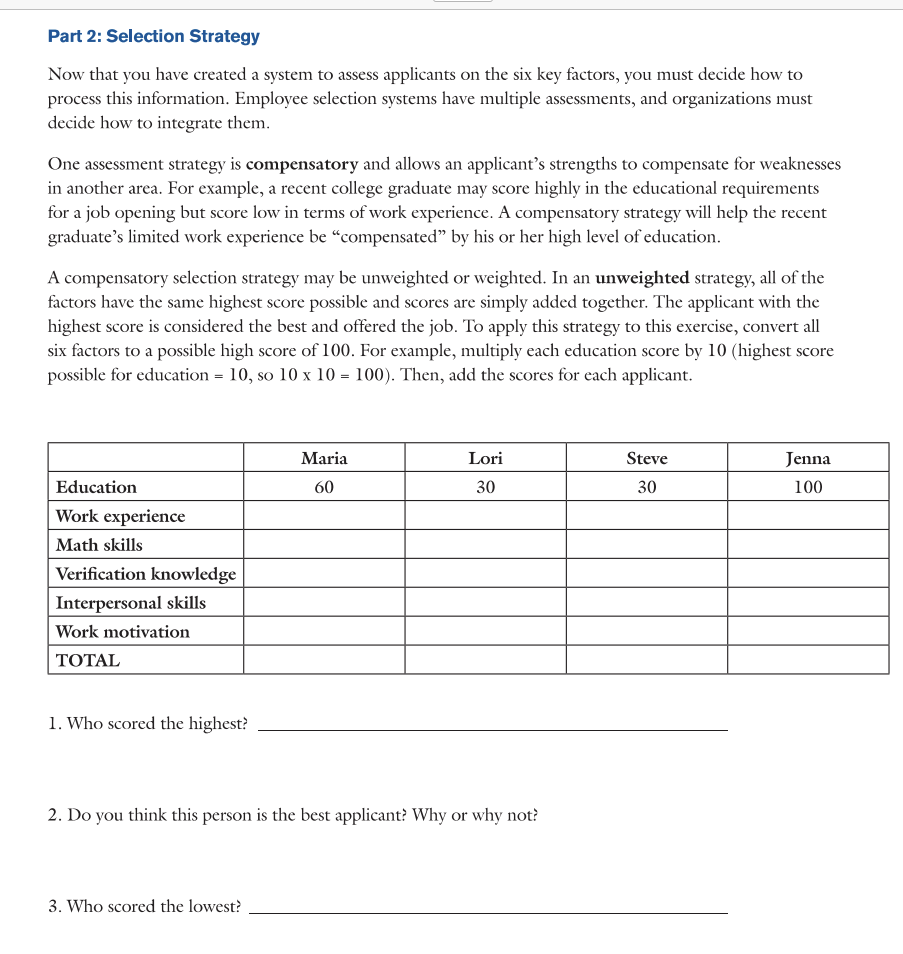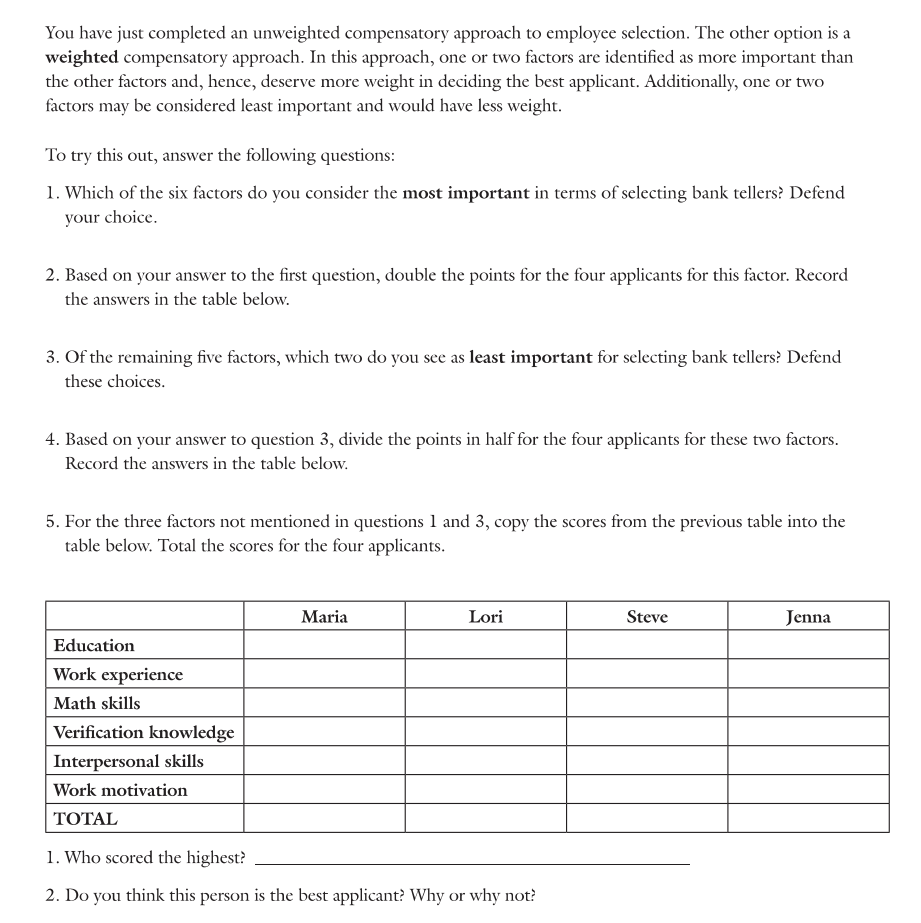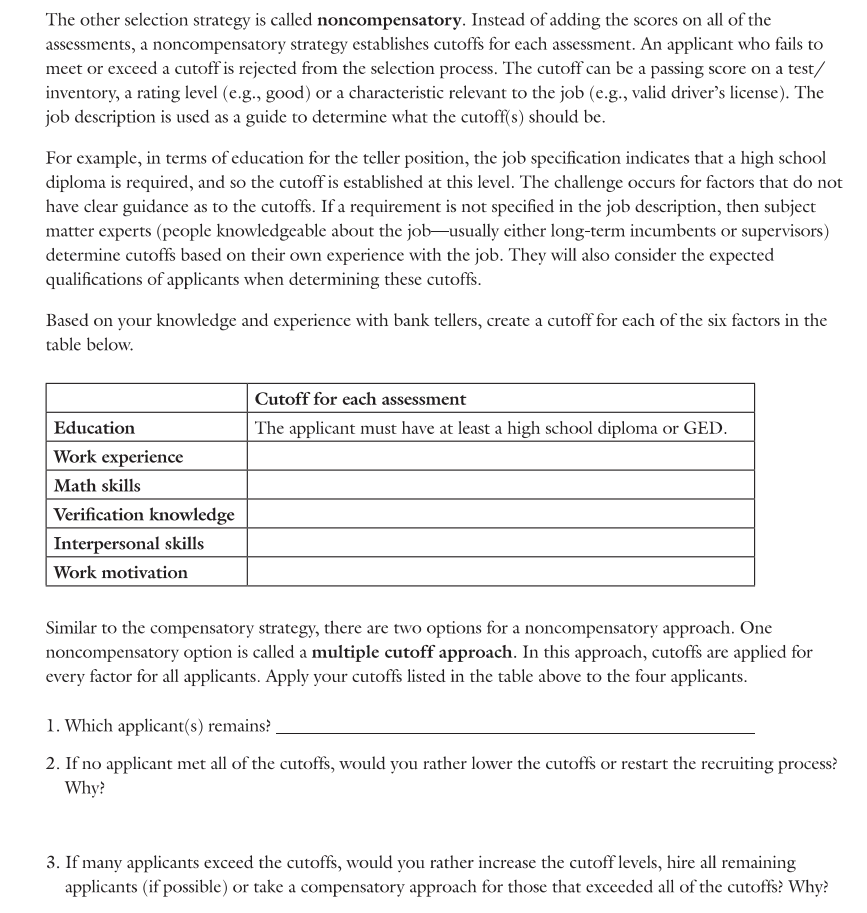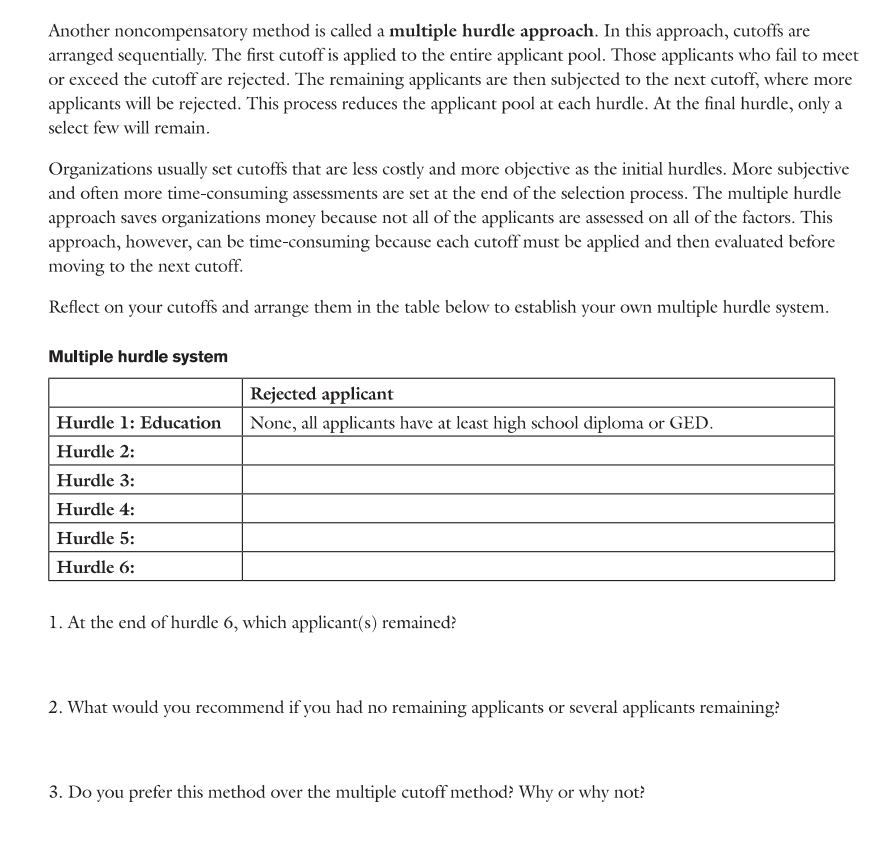Selection Strategy Slide
a. Recreate table and insert six factors, candidate name and convert all factors to a possible high score of 100. Then, add all the scores for each applicant. Insert the new table, three questions and answers on a new slide. This will be the unweighted strategy.
b. Develop a slide for the weighted strategy. Answer questions 1 5; recreate table and place questions/answers on this slide. Then, add question 1 4 and answer on the same slide.
c. Develop a slide for the non-compensatory strategy. Insert a table of the six factors and create a cutoff for each. Then, add the three questions and answer on the slide.



 d. Develop a slide for the multiple hurdle approach. Insert a table of the six hurdles/factors and complete. Then, add the three questions and answer on the slide
d. Develop a slide for the multiple hurdle approach. Insert a table of the six hurdles/factors and complete. Then, add the three questions and answer on the slide
You have just completed an unweighted compensatory approach to employee selection. The other option is a weighted compensatory approach. In this approach, one or two factors are identified as more important than the other factors and, hence, deserve more weight in deciding the best applicant. Additionally, one or two factors may be considered least important and would have less weight. To try this out, answer the following questions: 1. Which of the six factors do you consider the most important in terms of selecting bank tellers? Defend your choice. 2. Based on your answer to the first question, double the points for the four applicants for this factor. Record the answers in the table below. 3. Of the remaining five factors, which two do you see as least important for selecting bank tellers? Defend these choices. 4. Based on your answer to question 3, divide the points in half for the four applicants for these two factors. Record the answers in the table below. 5. For the three factors not mentioned in questions 1 and 3 , copy the scores from the previous table into the table below. Total the scores for the four applicants. 1. Who scored the highest? 2. Do you think this person is the best applicant? Why or why not? Part 2: Selection Strategy Now that you have created a system to assess applicants on the six key factors, you must decide how to process this information. Employee selection systems have multiple assessments, and organizations must decide how to integrate them. One assessment strategy is compensatory and allows an applicant's strengths to compensate for weaknesses in another area. For example, a recent college graduate may score highly in the educational requirements for a job opening but score low in terms of work experience. A compensatory strategy will help the recent graduate's limited work experience be "compensated" by his or her high level of education. A compensatory selection strategy may be unweighted or weighted. In an unweighted strategy, all of the factors have the same highest score possible and scores are simply added together. The applicant with the highest score is considered the best and offered the job. To apply this strategy to this exercise, convert all six factors to a possible high score of 100 . For example, multiply each education score by 10 (highest score possible for education =10, so 1010=100 ). Then, add the scores for each applicant. 1. Who scored the highest? 2. Do you think this person is the best applicant? Why or why not? Another noncompensatory method is called a multiple hurdle approach. In this approach, cutoffs are arranged sequentially. The first cutoff is applied to the entire applicant pool. Those applicants who fail to meet or exceed the cutoff are rejected. The remaining applicants are then subjected to the next cutoff, where more applicants will be rejected. This process reduces the applicant pool at each hurdle. At the final hurdle, only a select few will remain. Organizations usually set cutoffs that are less costly and more objective as the initial hurdles. More subjective and often more time-consuming assessments are set at the end of the selection process. The multiple hurdle approach saves organizations money because not all of the applicants are assessed on all of the factors. This approach, however, can be time-consuming because each cutoff must be applied and then evaluated before moving to the next cutoff. Reflect on your cutoffs and arrange them in the table below to establish your own multiple hurdle system. Multiple hurdle system 1. At the end of hurdle 6 , which applicant(s) remained? 2. What would you recommend if you had no remaining applicants or several applicants remaining? 3. Do you prefer this method over the multiple cutoff method? Why or why not? The other selection strategy is called noncompensatory. Instead of adding the scores on all of the assessments, a noncompensatory strategy establishes cutoffs for each assessment. An applicant who fails to meet or exceed a cutoff is rejected from the selection process. The cutoff can be a passing score on a test/ inventory, a rating level (e.g., good) or a characteristic relevant to the job (e.g., valid driver's license). The job description is used as a guide to determine what the cutoff(s) should be. For example, in terms of education for the teller position, the job specification indicates that a high school diploma is required, and so the cutoff is established at this level. The challenge occurs for factors that do not have clear guidance as to the cutoffs. If a requirement is not specified in the job description, then subject matter experts (people knowledgeable about the job-usually either long-term incumbents or supervisors) determine cutoffs based on their own experience with the job. They will also consider the expected qualifications of applicants when determining these cutoffs. Based on your knowledge and experience with bank tellers, create a cutoff for each of the six factors in the table below. Similar to the compensatory strategy, there are two options for a noncompensatory approach. One noncompensatory option is called a multiple cutoff approach. In this approach, cutoffs are applied for every factor for all applicants. Apply your cutoffs listed in the table above to the four applicants. 1. Which applicant(s) remains? 2. If no applicant met all of the cutoffs, would you rather lower the cutoffs or restart the recruiting process? Why? 3. If many applicants exceed the cutoffs, would you rather increase the cutoff levels, hire all remaining applicants (if possible) or take a compensatory approach for those that exceeded all of the cutoffs? Why



 d. Develop a slide for the multiple hurdle approach. Insert a table of the six hurdles/factors and complete. Then, add the three questions and answer on the slide
d. Develop a slide for the multiple hurdle approach. Insert a table of the six hurdles/factors and complete. Then, add the three questions and answer on the slide





